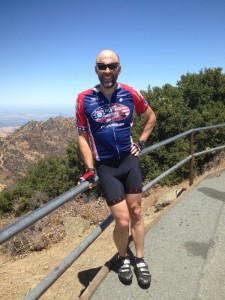 BICYCLE WITH CONFIDENCE by Martin Clinton
BICYCLE WITH CONFIDENCE by Martin Clinton
Secrets of the bike lane
A bike lane seems like a very simple idea, but many motorists and even experienced bicycle riders are often mistaken about the rules controlling this part of the road. Let’s play a game of True or False!
1. Any white line at the edge of the road creates a bike lane – False A bike lane must have those words painted in the lane, or a painted bike logo, or signs posted at the edge of the street. Without that marking the paint is just an edge line or marks the road shoulder (which has a different set of rules!).
2. No autos can park in a bike lane – False Unless there is a “No Parking” sign it’s OK to park, and in some cities the bike lanes are often blocked by parked cars. A better layout for a street where parking is permitted is to have a parking lane against the curb and a bike lane clearly positioned to the left of the parking area. Be careful riding past parked cars.
3. An auto is not permitted to drive in the bike lane – False A car can cross the bike lane to enter a driveway or parking lot. Any motor vehicle turning right is required to do so from the right hand edge of the road, and this often involves merging into the bike lane. Like any merge action, traffic moving into a lane must yield to a motor vehicle or bicycle already in the lane.
4. The Bike Lane line is dashed in some places to save the cost of paint – False Near an intersection the line is dashed to encourage turning vehicles to merge into the bike lane.
5. A turning auto must not enter the bike lane before the dashed line starts – False The dashed section is typically about 50 feet in length. Merging into the bike lane is permitted 200 feet before the intersection!
6. If motor traffic is slow or stopped, a bike can pass in the bike lane on the drivers’ right side – True Just as highway lanes move at different speeds when traffic is heavy, sometimes the bike lane is faster. But be careful! Remember that a driver may suddenly decide to merge into the bike lane to make a right turn at the next intersection, or even to turn around in a parking lot. When traffic is stopped an impatient passenger might decide to open a door and step out. You have to be ready for these surprises!
7. If the bike lane disappears before an intersection, it’s because the engineer doesn’t care about bicyclists – False Well, I certainly hope the engineer cares about bicyclists! The truth is that regular lanes and a bike lane mainly act to separate vehicles moving at different speeds, between intersections. At an intersection or traffic signal all vehicles, including bikes, position themselves in a lane according to the direction they want to travel, whether turning or going straight ahead.
8. If there is a bike lane at an intersection, bikes must stay in it – False Usually the bike lane at a traffic signal or stop sign is for bikes going straight through the intersection, and the lane is positioned to the right of straight-ahead motor traffic. If you are turning right, stay in the right-turn lane. If you are turning left, the best place to be is in the left-turn lane. Some years ago bike lanes were often painted at the right edge of an intersection even if there was a right-turn lane. This was a mistake, so don’t be fooled into thinking this is where to stay when you need to ride straight or turn left.
Understand bike lanes. Know the rules. And bicycle with confidence!

